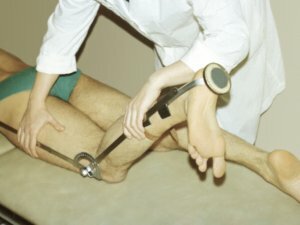Exostosis: Causes, Symptoms and Treatment
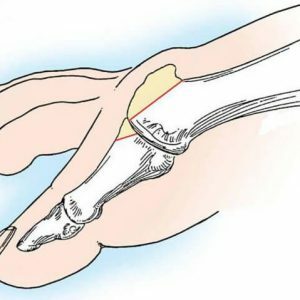
Exostosis - bone or bone-cartilaginous growth of the bone of non-tumor etiology.Initially, a bone develops on the bone, consisting of cartilaginous tissue, which later becomes more rigid, gradually degenerating into a spongy bone.The surface of the newly formed bone remains covered with cartilage, which solidifies.
This cycle can be repeated indefinitely, providing tumor growth.The process proceeds painlessly, developing extremely slowly.The maximum tumor size reaches ten centimeters or more. Neoplasm is manifested, as a rule, during the growth of bones and the formation of the skeleton in adolescence.
Table of contents: Causes of exostosis development Forms and localization of exostosis Diagnosis and treatment of exostosis Complications PreventionCauses of exostosis development
According to some experts, the reasons for the appearance of this disease may be hereditary abnormalities, but this theory has not been scientifically confirmed.
The main factors for the appearance of exostoses are:
- various inflammatory processes;
- bruises and bone injuries;
- disorders of periosteum and cartilage development;
- endocrine disorders;
- infectious diseases of various etiologies.
The most significant factor provoking the emergence of exostosis, is the excess of calcium in the human body, which is just deposited on the bones and forms outgrowths. Causes of excess calcium levels can be excessive consumption of dairy products, eggs, parsley, cabbage, hard water.
The second name of the eczostosis is the osteochondrom .So in medicine is called a benign bone tumor, consisting of bone-cartilaginous tissue.In early childhood, this disease is diagnosed extremely rarely, its development is observed mainly during puberty in adolescents.
Forms and localization of exostosis
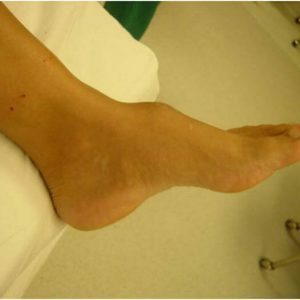 When is a solitary form of bone-cartilaginous exostosis, a single tumor is observed.It is motionless, and can be of different sizes.Expanding to a considerable extent, the neoplasm can exert pressure on the nerves, blood and lymph vessels.
When is a solitary form of bone-cartilaginous exostosis, a single tumor is observed.It is motionless, and can be of different sizes.Expanding to a considerable extent, the neoplasm can exert pressure on the nerves, blood and lymph vessels.
The second form is multiple exostosis chondrodysplasia .In this case, several tumors are observed.It is believed that it is this type of disease that is most prone to inheritance.
Femoral and tibia are the preferred places for exostosis localization - they account for about half of the cases. Also in the "risk group" are the hip bone, scapula, collarbone, shoulder joint.The bones of the feet and hands suffer extremely seldom, and on the cranial bones the cases of appearance of tumors are not officially recorded.
The most dangerous location for exostosis is the spine .With the growth of the tumor, compression of the spinal cord is possible, which can lead to serious violations of the central nervous system.There is also the risk of degeneration of benign formation into malignant.
Diagnosis and treatment of exostosis
The disease develops extremely slowly, this process passes absolutely without any symptoms.Signs in the form of pain, dizziness, headache, numbness of body parts, sensation of goosebumps are possible when the tumor is squeezed by the tumor of blood vessels and nerves.
The disease is either visually( when the growth is large enough), or accidentally during the X-ray diagnosis of other diseases. The final diagnosis of exostosis is determined only by X-ray.
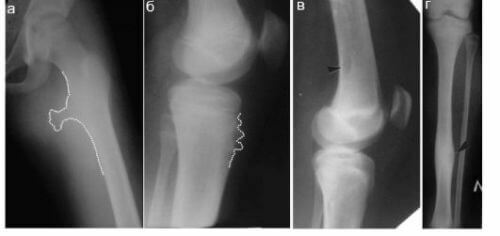
Note: , when determining the size and shape of a tumor, one should not forget that the image shows only the bone part of the built-up edge, and the cartilaginous tissue is not detected.Therefore, the true size of the tumor will be different from the one shown in the x-ray image.
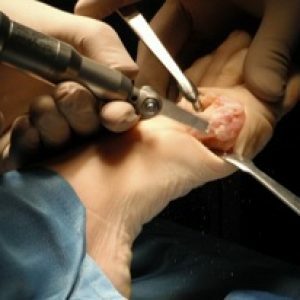 Treatment of exostosis is possible only by surgical methods. There is simply no medical treatment for this disease.Carrying out the rapid removal of growths is not recommended for persons who have not reached the age of majority, since growths in the formation of bone tissues can disintegrate by themselves.
Treatment of exostosis is possible only by surgical methods. There is simply no medical treatment for this disease.Carrying out the rapid removal of growths is not recommended for persons who have not reached the age of majority, since growths in the formation of bone tissues can disintegrate by themselves.
Surgical intervention is indicated in case of rapid development of the neoplasm, especially if due to the large size, the nerves or blood vessels are infringed.The operation can be performed both under anesthesia and under local anesthesia.The choice of method of anesthesia depends on the size and location of the tumor.The technique of carrying out the intervention is quite simple, bone formation is removed with the help of a bit, and the site of damage on the bone is smoothed out.
The recovery period lasts about a couple of weeks.If surgical intervention was insignificant, for example, one small tumor was removed, then the next day the patient is able to move independently .At the first stage of recovery it is important to observe the most gentle mode of motion.After the swelling has completely subsided or is reduced to a minimum, restorative therapy begins.Recovery is reduced to exercises aimed at regaining lost muscle mass and strength.When the training stops to cause physical pain and cause discomfort, then rehabilitation can be considered successfully completed.
Complications
In principle, exostosis does not apply to diseases that cause dangerous complications.But in case of localization of a tumor on the spine, there may be a compression effect on the spinal cord, which is fraught with the most serious consequences. Very rarely diagnosed fracture of the exostosis leg.Multiple chondrodysplasia in childhood and adolescence, in some cases, can lead to a disruption in the proper development and deformation of the skeleton.Sometimes, especially with rapid growth, tumors can degenerate from benign to malignant, which are most often manifested in the form of chondrosarcoma or spindle cell sarcoma, the favorite places of localization are pelvic bones, spine, thighs, scapula.
Prophylaxis
Prevention as such is reduced to identifying exostoses at the earliest stages. Regular medical examinations contribute to the achievement of these goals.Given the risk of deformity of the skeleton, early diagnosis is especially relevant for children and adolescents.Inspection is also necessary after injuries of the musculoskeletal system, because an impetus to the emergence of pathology can serve even a minor injury or fracture.And, as mentioned above, it is highly desirable to regularly monitor the level of calcium in the body, because people with high calcium content are at risk.
By and large, despite the etiology, exostosis does not belong to the group of dangerous diseases.Rebirth of a tumor into a malignant is extremely rare.This neoplasm does not pose a serious danger to human life and health.In children, cases of cure are spontaneous, without medication.
Tsygankova Yana Aleksandrovna, medical reviewer, therapeutist of the highest qualification category


